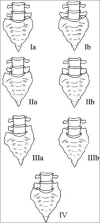Bertolotti's syndrome in low-backache population: Classification and imaging findings
- PMID: 31007488
- PMCID: PMC6450150
- DOI: 10.4103/tcmj.tcmj_209_17
Bertolotti's syndrome in low-backache population: Classification and imaging findings
Abstract
Objective: Lumbosacral transition vertebrae (LSTVs) are associated with alterations in biomechanics and anatomy of spinal and paraspinal structures, which have important implications on surgical approaches and techniques. LSTVs are often inaccurately detected and classified on standard anteroposterior radiographs and magnetic resonance imaging. The use of whole-spine images as well as geometric relationships between the sacrum and lumbar vertebra increases accuracy. The diagnosis of symptomatic LSTV is considered with appropriate patient history and imaging studies. This study aimed to classify the anatomical variations in LSTV and determine, by plain radiography, if there exists a relationship between sacralization and low backache (LBP).
Materials and methods: Five hundred lumbosacral radiographs of LBP patients were examined after obtaining prior consent from the patient and approval from the "institutional ethics committee." Data collection consisted of the patient's age at the time of imaging gender and number of lumbar vertebral bodies. Dysplastic transverse processes were classified according to the Castellvi radiographic classification system. The incidence of sacralization in patients and the control groups was reported, and the anomaly was compared according to the groups.
Results: Of these patient groups, 134 were classified as positive for sacralization, which resulted in an incidence of 26.8%. The most common anatomical variant was Castellvi Type IA (7.6%). There were no statistically significant differences between men and women who had anomaly (P = 0.9256). Higher incidences of Type IB and Type IIB were found in men, but those results were not statistically significant (P = 0.133 and P = 0.581, respectively) when compared with the female group. Daily frequency and intensity of LBP were assessed in patients using visual analog scale (VAS) scores. The patients with LBP and no malformation reported an average pain level on the VAS for pain of 2.2 versus 5.2 in patients with LBP and a transitional vertebra, respectively.
Conclusion: Based on our data, we conclude that lumbosacral transitional segments are a common cause in the low-backache population. However, no relationship was found between age and genders in this study. However, in comparison with the nonspecific low-backache group, the VAS scores were significantly higher and the pain duration was significantly longer in the LSTV group.
Keywords: Castellvi classification; Low backache; Lumbarization; Lumbosacral transition vertebra; Sacralization.
Conflict of interest statement
There are no conflicts of interest.
Figures
Similar articles
-
Surgical Treatment of a Rare Presentation of Bertolotti's Syndrome from Castellvi Type IV Lumbosacral Transitional Vertebra: Case Report and Review of the Literature.J Neurol Surg Rep. 2018 Jul;79(3):e70-e74. doi: 10.1055/s-0038-1667172. Epub 2018 Jul 30. J Neurol Surg Rep. 2018. PMID: 30083494 Free PMC article.
-
A Review of Symptomatic Lumbosacral Transitional Vertebrae: Bertolotti's Syndrome.Int J Spine Surg. 2015 Jul 29;9:42. doi: 10.14444/2042. eCollection 2015. Int J Spine Surg. 2015. PMID: 26484005 Free PMC article.
-
Lumbar plain radiograph is not reliable to identify lumbosacral transitional vertebra types according to Castellvi classification principle.BMC Musculoskelet Disord. 2020 May 29;21(1):333. doi: 10.1186/s12891-020-03358-3. BMC Musculoskelet Disord. 2020. PMID: 32471475 Free PMC article.
-
Clinical assessment and management of Bertolotti Syndrome: a review of the literature.Spine J. 2021 Aug;21(8):1286-1296. doi: 10.1016/j.spinee.2021.02.023. Epub 2021 Mar 3. Spine J. 2021. PMID: 33676018 Review.
-
Partial Lumbosacral Transitional Vertebra: A case of unilateral sacralization and its embryological and clinical implications.Kathmandu Univ Med J (KUMJ). 2019 Jul-Sept.;17(67):245-247. Kathmandu Univ Med J (KUMJ). 2019. PMID: 33305756 Review.
Cited by
-
Axial Spondyloarthritis: Mimics and Pitfalls of Imaging Assessment.Front Med (Lausanne). 2021 Apr 22;8:658538. doi: 10.3389/fmed.2021.658538. eCollection 2021. Front Med (Lausanne). 2021. PMID: 33968964 Free PMC article. Review.
-
Effect of lumbosacral transitional vertebra on developmental alterations of the hip: a quantitative investigation of the lumbo-pelvic-hip complex via whole-body computed tomography.Quant Imaging Med Surg. 2024 Jul 1;14(7):4635-4647. doi: 10.21037/qims-23-1816. Epub 2024 Jun 11. Quant Imaging Med Surg. 2024. PMID: 39022269 Free PMC article.
-
A Whole Spine MRI Based Study of the Prevalence, Associated Disc Degeneration and Anatomical Correlations of Lumbosacral Transitional Vertebra.Global Spine J. 2024 Sep;14(7):1952-1958. doi: 10.1177/21925682231161559. Epub 2023 Mar 3. Global Spine J. 2024. PMID: 36867110 Free PMC article.
-
A Semi-quantitative Evaluation of Out-to-Out Agenesis of Posterior Wall in a Dry Human Sacrum in Bangladesh.Cureus. 2022 Nov 6;14(11):e31163. doi: 10.7759/cureus.31163. eCollection 2022 Nov. Cureus. 2022. PMID: 36349077 Free PMC article.
-
Prevalence of Bertolotti's Syndrome in Lumbosacral Surgery Procedures.Cureus. 2022 Jun 26;14(6):e26341. doi: 10.7759/cureus.26341. eCollection 2022 Jun. Cureus. 2022. PMID: 35903576 Free PMC article.
References
-
- Hughes RJ, Saifuddin A. Imaging of lumbosacral transitional vertebrae. Clin Radiol. 2004;59:984–91. - PubMed
-
- Mahato NK. Redefining lumbosacral transitional vertebrae (LSTV) classification: Integrating the full spectrum of morphological alterations in a biomechanical continuum. Med Hypotheses. 2013;81:76–81. - PubMed
-
- Mahato NK. Complexity of neutral zones, lumbar stability and subsystem adaptations: Probable alterations in lumbosacral transitional vertebrae (LSTV) subtypes. Med Hypotheses. 2013;80:61–4. - PubMed
LinkOut - more resources
Full Text Sources
Miscellaneous



